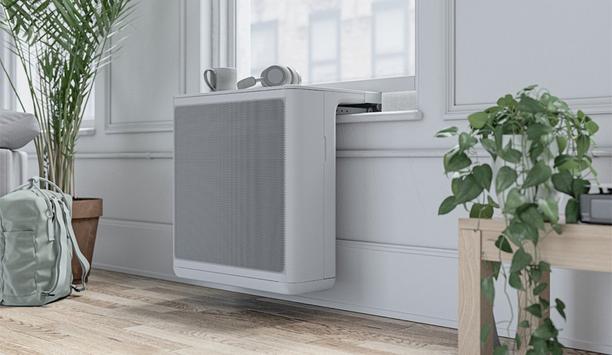EPA - Editor's Note
Data centers play a pivotal role in supporting the flow of information across our digital economy. However, the transmission of large amounts of data also requires a lot of energy. Viewing data centers as potential heat sources offers an opportunity to use this otherwise wasted heat to warm nearby homes and businesses using technologies like heat pumps and heat networks. The approach will lower the environmental impact of these buildings filled with computer servers, and it will support the tr...
Certifications are official documents given by professional organizations that confirm a staff member has the necessary knowledge and skills needed to do a specific job. In the HVAC industry, certifications provide multiple benefits for various stakeholders. For technicians, certifications can demonstrate enhanced skills and knowledge, increase earning potential, improve job security, and promote greater credibility and professionalism. Certified technicians In the long run, using certified...
Hydronics systems rely on water, steam, or water solutions to distribute heating and cooling throughout a building. They are inherently more eco-friendly than conventional alternatives. First and foremost, using water as a temperature regulation method is a natural choice. There is no carbon footprint involved in its creation, and there is no inherent danger in exposure to water in the event of a system failure. Water is more efficient at carrying heating and cooling loads than other technolog...
SNAP Rule 26 marks an important milestone in the transition from commercial refrigeration to new refrigerants. The rule lists refrigerant substitutes that provide a spectrum of technological solutions to meet required performance, global warming potential (GWP), safety, and environmental standards. SNAP stands for Significant New Alternatives Policy, a program by the U.S. EPA (Environmental Protection Agency) under the Clean Air Act. In general, the program aims to evaluate and regulate...
The flammability of the new class of low-GWP refrigerants is a source of misunderstanding and unnecessary anxiety among contractors who will be working with the newer materials, which must be used by HVAC equipment manufactured beginning Jan. 1, 2025. A2L refrigerants The newer A2L refrigerants, specifically R-454B, perform similarly to previously used materials such as R-410A, and flammability is so mild as to be almost negligible. What’s needed is more education to make co...
The idea of Energy as a Service involves shifting the traditional business model from selling energy as a commodity to providing a comprehensive package of goods and services to address a customer’s energy use and management. Rather than selling energy, the approach encompasses complete stewardship of a company’s energy needs in exchange for a monthly fee. Because 40% or so of a company’s typical energy needs are related to heating and cooling systems, implementing Energy as...
Businesses in the HVAC market were high-profile participants at the COP28 conference in Dubai. Several big HVAC companies had a presence at the conference, and the industry’s technologies are an important tool to achieve the conference’s stated climate goal of net-zero global greenhouse gas emissions by 2050. COP28 The Conference of Parties of the United National Framework Convention on Climate Change (COP28) took place Nov. 30-Dec. 12 in Dubai. Some 35,000 people were involved in...
Revised building codes, based on model “I-Codes” developed by the International Code Council (ICC), are being widely adopted to allow A2L refrigerants to be used in comfort air conditioning applications. Previously, the use of A2L refrigerants, which are “mildly flammable,” was not allowed by building codes in force in 2021 and before because of safety concerns. benefits of A2Ls However, the benefits of using A2Ls instead of refrigerants with higher global...
The transition away from hydrofluorocarbons (HFCs) as refrigerants for HVAC systems is well underway, and the process is accelerating. A 10% reduction in HFC production was mandated last year, and an additional 30% reduction is pending in January 2024. Meanwhile, a January 2025 deadline looms for the elimination of the manufacture of HVAC equipment that uses refrigerants with high potential for global warming (GWP). impact of regulatory shifts The production step-downs ensure a co...
The steps toward building decarbonization will accelerate organizations’ net-zero journey. Taking steps will also reduce operational costs and deliver better indoor environments. Improvements in heat pumps and digital solutions have enabled these opportunities and, as they continue to advance, deeper and deeper building decarbonization will become achievable. Optimal solutions Mark Lessans, Senior Director of Sustainability and Regulatory Affairs, Johnson Controls, for insights into how...
From supply chain challenges to decarbonization, from data analytics to maintenance programs, the themes that ranked highest among visitors to HVACinformed.com in 2022 reflected the dominant topics of conversation throughout the industry. As demonstrated by the most-read articles on the site, technology trends and regulatory issues all converged and had a profound impact on the industry in 2022. Timely and important issues in the HVAC marketplace dominate HVACinformed.com‘s list of most-c...
The U.S. Department of Energy (DoE) has challenged manufacturers to accelerate the development of heat pumps that can perform well in colder climates. As part of its Initiative for Better Energy, Emissions, and Equity (E3 Initiative), the DoE’s Residential Cold Climate Heat Pump (CCHP) Technology Challenge seeks to demonstrate performance in the lab and at pilot sites before implementing new technologies in the market. Nominal capacity requirement To meet the DoE CCHP Challenge, a heat...
California is moving to ban the sale of natural gas furnaces, heaters and water heaters by 2030. It is the first US state to make the move, in order to meet federal ozone standards. In addition to California’s previous efforts to eliminate installation of gas-fueled equipment in new buildings, the new regulation will address the use of gas space heaters and water heaters in existing residential buildings. When it comes time to replace them, building owners will be required to transition...
New tax credits and rebates are poised to infuse billions of dollars into the HVAC marketplace in the United States, making a variety of high-efficiency technologies more affordable for consumers and generating additional revenue in the HVAC market for years to come. clean energy investments A new law provides Americans with access to $370 billion for clean energy investments in the form of tax credits, incentives, and rebates to improve energy efficiency. There is also a tax deduction for own...
HVAC systems account for around 46% of the average U.S. home’s energy consumption. As big users of electricity, air conditioning (AC) systems this summer face continuing concerns about an adequate supply of electricity and the reliability of the U.S. electrical grid. According to a report from the North American Electric Reliability Corporation (NERC), large parts of the country are at either ‘high’ or ‘elevated’ risk of electricity shortfalls this summer. Notably,...
Among the requirements of the American Innovation and Manufacturing (AIM) Act of 2020 is a ban on disposable, single-use cylinder tanks used to transport refrigerants through the supply chain to an HVAC installer. A final rule posted by the Environmental Protection Agency (EPA) on October 5, 2021, will prohibit the use of disposable cylinders in the next several years. HVAC installers use the disposable cylinders every day to transport hydrofluorocarbon (HFC) refrigerants including R32...
Demand for HVAC services spiked during the coronavirus (COVID-19) pandemic. Low interest rates, government stimulus checks and a greater emphasis on home improvement (because more people were spending time at home) drove new business for HVAC companies. However, labor shortages limited companies’ ability to meet the demand. In some cases, money was left on the table. There was another impact of the pandemic on industry labor trends: HVAC contractors kept working, even when much of the eco...
Gradient seeks to bring the benefits of mini-split systems - variable speed drive, efficient operation, heat pump heating - to a wider audience, by simplifying the installation process. Gradient offers a design that is installed in a window, but it has more similarities to mini-split systems than to a window air conditioner. simple installation The system is designed for simple installation by a layman – it generally takes about 15 minutes. Using heat pump technology, Gradient has the e...
Climatech of Professional Air in Pensacola, Florida, USA, is known for putting HVAC customers first by providing first-class service and for doing what’s right, even when no one is looking. “We approach each customer like it’s our grandmother,” said Travis Thompson of Climatech of Professional Air, adding “We show all the options and we are fair with pricing. The open-book approach to options and our honest opinion is the best way. We sit and get to know the custome...
‘As a service’ is a familiar pattern in business today, especially in the technology arena. ‘Software as a Service’ is as common as Microsoft Office 365 and companies have been providing services, such as telephony and internet access for decades. But, how can the model be applied to the HVAC market? It’s not a common approach today, but the benefits of applying ‘As a service’ to HVAC are many – for customers and for equipment and service provider...
The story of Bluon is the tale of how a chemical company blended a new refrigerant, and then later evolved into a large, brand-agnostic online community that helps technicians do their job. Currently, Bluon is on the verge of monetizing its platform, linking e-commerce into its vast wellspring of technical information to guide HVAC installers. Tdx 20 refrigerant blend Bluon created and received EPA approval for its Tdx 20 refrigerant blend (R-458A) to replace R-22 and provide 20% great...
With a required 15% increase in seasonal efficiency looming in 2023, original equipment manufacturers (OEMs) are being challenged to design HVAC rooftop units (RTUs) that both meet the immediate efficiency requirements and also set the stage for a refrigerant transition in 2025 and beyond. Meeting the challenges requires that new hardware designs be more than ‘a little bit better’; rather, complete shifts in technology are called for. Insights on the changing technologies and regulat...
Rooftop units (RTUs) withstand a lion’s share of the burden, when it comes to heating and cooling commercial buildings, and they also represent a big portion of a building’s impact on global warming. Traditional low-tech approaches to controlling RTUs have failed to address global warming concerns, and these units, operating independently, may not even deliver sufficiently on the climate demands of a building. Intelligent approach to managing energy demand Providing an intelligent...
AHR Expo was back in a big way for 2022, reflecting a dynamic industry that not only survived the pandemic but has found new ways to thrive. Technical developments on display in Las Vegas spanned traditional product categories, which continued to display new levels of innovation in a mature market. Also reflecting progress were new digital offerings that increase control and efficiency of HVAC products and link them to the expanding world of data. Omar Tabba, the Chief Product Officer at...
It’s great time to be in the HVAC industry. That was the optimistic vibe as the AHR Expo opened in Las Vegas, the first such in-person gathering of the industry since the beginning of the global pandemic. Attendance was moderate and steady throughout the first day of the show as HVAC professionals took stock of technology developments that have emerged over the last two years. COVID changed the HVAC market, probably forever, and the changes extend beyond the masks that were dutifully wor...
A new installation is using natural heat from groundwater to regulate the indoor climate of The Glen Mhor Hotel in Scotland. The groundwater is further heated by two electric heat pumps and distributed to guest rooms and apartments through a small heating district network. From the system, which is slated for completion this spring, the water will return to the sand and gravel layers in shallow ground around Inverness, and eventually back to the River Ness. The design, which replaces 20 gas-fir...
The HVAC market is moving fast. Supply shortages, technology trends and regulatory issues all converged and had a profound impact on the industry in 2021, even as the lingering impact of the COVID-19 pandemic also made a mark. Looking back at the top articles of the year at HVACInformed.com, as measured by those that received the most ‘clicks’ on the website, provides a decent summary of how the industry evolved in 2021. Top 10 articles posted at HVACInformed.com in 2021 Timely and...
HVAC systems typically operate on a schedule. Heating, cooling and ventilation systems start and stop at fixed times of the day, scheduled around when and how a building is used. But, shouldn’t the number of occupants in a building or a room have an impact on how the HVAC system operates? Considering occupancy, when addressing HVAC needs, is an especially timely approach, given that building schedules are less predictable now, since the COVID-19 pandemic changed work patterns, possibly fo...
Society is prioritizing the mitigation of climate change, and new, potentially flammable, low-Global Warming Potential (GWP) refrigerants are a key tool in broadly lowering the rate of global warming. The detection of fugitive (leaking) refrigerant is a new regulation emerging as HVAC equipment manufacturers convert to low-GWP refrigerants. Both A2L and A3 low-GWP refrigerants, while climate-friendly, are flammable. As such, OEMs will have to integrate refrigerant sensors that detect leaked ref...
Natural gas heating and cooking are coming under more scrutiny, especially their negative impact on indoor air quality. In particular, nitrogen dioxide (NO2) emitted from gas stoves and furnaces aggravate childhood asthma. The issue has been obvious for years but is now getting renewed attention of regulators. Gas heating and cooking are popular throughout the United States and Europe. One estimate is that a third of U.S. homes use natural gas for cooking, which has been promoted for decades as...


































